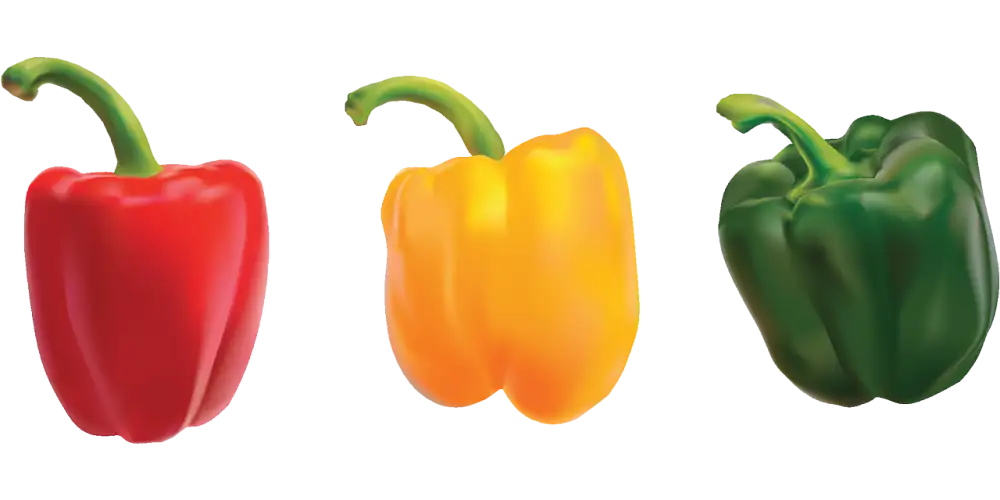Discover the Fiery Delight: Unveiling the Secrets of Red Peppers

Red peppers, also known as bell peppers or sweet peppers, are vibrant and versatile vegetables that add a burst of color and flavor to any dish. They belong to the Capsicum annuum family and come in various shades of red, ranging from bright crimson to deep maroon. With their crisp texture and mild sweetness, red peppers have become a staple ingredient in cuisines around the world. Whether used raw in salads or cooked in stir-fries, soups, or stews, these fiery delights are sure to elevate your culinary creations to new heights. So let's dive into the world of red peppers and uncover their secrets!
Nutritional Value of Red Peppers
Red peppers are not only delicious but also packed with essential nutrients. They are low in calories and fat, making them a healthy addition to any diet. Red peppers are an excellent source of vitamin C, providing more than 100% of the recommended daily intake in just one serving. They also contain vitamin A, vitamin B6, folate, and potassium. Additionally, red peppers are rich in antioxidants, which help protect the body against free radicals and reduce the risk of chronic diseases. With their impressive nutritional profile, red peppers are a fantastic choice for promoting overall health and well-being.
Health Benefits of Red Peppers
Red peppers not only add a burst of flavor to dishes, but they also offer numerous health benefits. Packed with vitamins A, C, and E, red peppers are excellent for boosting the immune system and promoting healthy skin. They also contain antioxidants that help fight inflammation and reduce the risk of chronic diseases like heart disease and cancer. Additionally, red peppers are low in calories and high in fiber, making them a great choice for weight management and digestive health. Incorporating red peppers into your diet can contribute to overall well-being and enhance your culinary experience.
Culinary Uses of Red Peppers
Red peppers are incredibly versatile and can be used in a variety of culinary creations. Their vibrant color and bold flavor make them a popular ingredient in many dishes.
One of the most common uses for red peppers is in salads. They add a sweet and slightly spicy kick to any salad, whether it's a simple green salad or a more elaborate pasta salad. Red peppers can also be roasted and added to sandwiches or wraps for an extra burst of flavor.
In addition to salads, red peppers are often used in stir-fries and sautés. Their crisp texture holds up well to high heat, making them perfect for quick-cooking dishes. They pair well with other vegetables, meats, and even seafood.
Red peppers can also be stuffed with various fillings, such as cheese, rice, or ground meat. This creates a delicious and visually appealing dish that is sure to impress guests.
For those who enjoy spicy food, red peppers can be used to make hot sauces or salsas. Their natural heat adds depth of flavor and a fiery kick to any sauce or dip.
Lastly, red peppers can be pureed into soups or sauces for added richness and depth of flavor. Their vibrant color adds visual appeal to any dish.
With their versatility and bold flavor profile, red peppers are an essential ingredient in many cuisines around the world. Incorporating them into your cooking will not only enhance the taste of your dishes but also provide numerous health benefits.
Different Varieties of Red Peppers
Red peppers come in various shapes, sizes, and heat levels. The most common variety is the bell pepper, which is sweet and mild. It is available in different colors such as red, yellow, and orange. Another popular variety is the cherry pepper, which is small and round with a slightly spicy flavor. Pimento peppers are heart-shaped and have a sweet taste, making them perfect for stuffing. For those who enjoy a fiery kick, there are hot red peppers like cayenne and habanero. Each variety offers a unique flavor profile that can elevate any dish to new heights of deliciousness.
How to Select and Store Red Peppers
When selecting red peppers, look for ones that are firm, glossy, and have a vibrant color. Avoid peppers with soft spots or wrinkled skin. The stem should be green and fresh-looking. Choose peppers that feel heavy for their size as they tend to be juicier.
To store red peppers, keep them in the refrigerator in a plastic bag or airtight container. They can stay fresh for up to a week when stored properly. Avoid washing the peppers until you're ready to use them as moisture can promote spoilage. If you have excess red peppers, consider freezing them by slicing or chopping them into desired sizes and placing them in freezer-safe bags.
Remember, freshness is key when it comes to enjoying the full flavor and nutritional benefits of red peppers.
Delicious Recipes featuring Red Peppers
1. Roasted Red Pepper Hummus: Blend roasted red peppers with chickpeas, garlic, tahini, lemon juice, and olive oil for a creamy and flavorful dip.
2. Stuffed Red Peppers: Fill halved red peppers with a mixture of cooked rice, ground meat, onions, and herbs. Bake until tender for a hearty and satisfying meal.
3. Red Pepper Pasta: Sauté sliced red peppers with garlic and olive oil. Toss with cooked pasta and grated Parmesan cheese for a simple yet delicious dish.
4. Red Pepper Soup: Simmer red peppers with onions, vegetable broth, and spices until soft. Puree until smooth and garnish with fresh herbs for a comforting soup.
5. Red Pepper Pesto: Blend roasted red peppers with basil, pine nuts, Parmesan cheese, garlic, and olive oil to create a vibrant pesto sauce that pairs perfectly with pasta or grilled meats.
These recipes showcase the versatility of red peppers in various cuisines and are sure to add a burst of flavor to your meals.
Fun Facts about Red Peppers
1. Red peppers are technically fruits, not vegetables, as they develop from the ovary of a flower and contain seeds.
2. The spiciness of red peppers is measured on the Scoville scale. The hotter the pepper, the higher its Scoville rating.
3. Red peppers are rich in vitamin C, containing more than twice the amount found in oranges.
4. Eating red peppers can help boost metabolism due to their capsaicin content, which increases calorie burning.
5. Red peppers come in various shapes and sizes, ranging from small cherry peppers to large bell peppers.
6. The vibrant red color of these peppers comes from a pigment called lycopene, which is also found in tomatoes.
7. Red peppers have been used for centuries in traditional medicine for their anti-inflammatory properties.
8. Capsaicin found in red peppers can stimulate endorphin production, leading to a natural mood boost and pain relief.
9. Red pepper flakes are commonly used as a seasoning and can add a spicy kick to any dish.
10. Red pepper plants belong to the nightshade family, along with tomatoes, potatoes, and eggplants.
Incorporating these fun facts into your knowledge about red peppers will enhance your appreciation for this fiery delight!
With their vibrant color, fiery taste, and numerous health benefits, red peppers are a must-have ingredient in any kitchen. Whether you prefer them raw in salads, roasted for a smoky flavor, or sautéed to add a kick to your dishes, there are endless ways to incorporate red peppers into your diet.
Not only do red peppers provide a burst of flavor to your meals, but they also offer a wide range of nutrients and antioxidants that promote overall well-being. From boosting immunity to improving heart health and aiding digestion, these versatile vegetables pack a powerful nutritional punch.
To make the most of red peppers' nutritional value, choose fresh and firm ones with glossy skin when selecting at the grocery store. Store them in the refrigerator to maintain their freshness for up to two weeks.
To get started on your culinary adventure with red peppers, try out some delicious recipes like stuffed bell peppers, roasted red pepper soup, or spicy red pepper hummus. These dishes will not only tantalize your taste buds but also impress your family and friends.
Fun fact: Did you know that red peppers have more vitamin C than oranges? They are also rich in vitamin A and contain capsaicin, which gives them their signature heat.
So why wait? Start incorporating these fiery delights into your diet today and experience the magic of red peppers firsthand. Your taste buds and body will thank you!
Published: 25. 11. 2023
Category: Food



